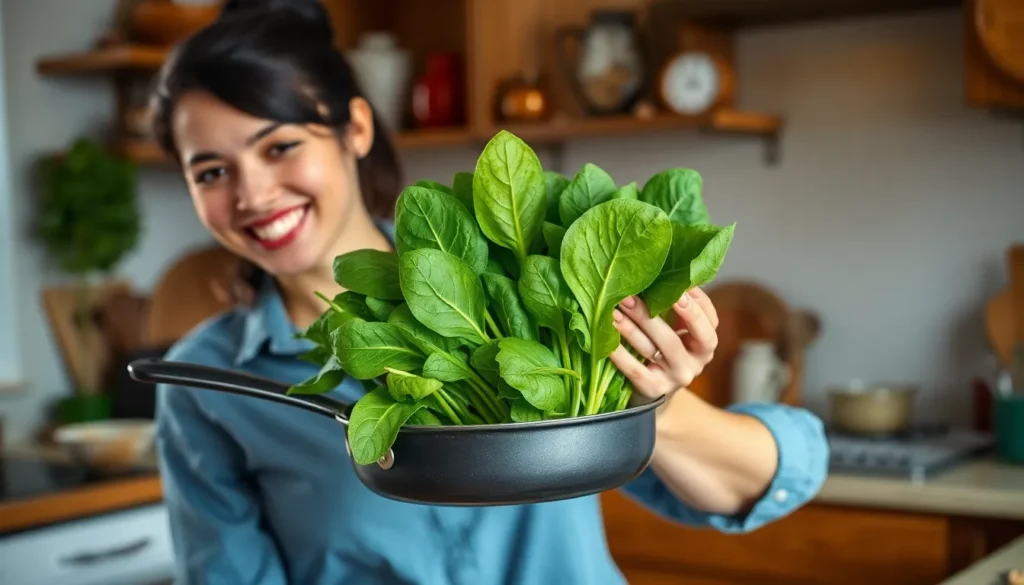Table of Contents
ToggleCooking spinach in a pan isn’t just a culinary task; it’s a delightful adventure waiting to unfold. With its vibrant green leaves and a host of health benefits, spinach deserves a spot in every kitchen. Who knew that this leafy green could transform into a delicious side dish in mere minutes?
Benefits Of Cooking Spinach
Cooking spinach offers numerous health advantages. Nutrient absorption increases when spinach is cooked. Cooking allows for easier digestion of the plant’s oxalates, which may hinder nutrient intake. Vitamin K, iron, and calcium levels become more accessible through heat.
Additionally, cooked spinach contains higher levels of transformative compounds that support heart health. Antioxidants, such as lutein and zeaxanthin, improve when spinach is sautéed. Sautéing enhances flavors and retains a vibrant green color, making it visually appealing.
Flexibility in preparation methods offers more culinary options. Whether sautéed, steamed, or boiled, cooked spinach complements a variety of dishes. Incorporating cooked spinach into meals enriches nutrient profiles. It acts as a low-calorie, flavorful addition to soups, salads, and main courses.
Cooking spinach also reduces its volume significantly. One cup of raw spinach reduces to one-half cup when cooked, making it easier to consume larger amounts. The enhanced taste can encourage more people to include it in their diets regularly.
Folic acid levels remain plentiful even after cooking. This B vitamin supports cell division and overall health, particularly during pregnancy. Serving cooked spinach as a side dish or as part of a main dish maximizes its benefits while appealing to different taste preferences.
Cooking spinach delivers multiple health benefits and enhances its usability in the kitchen. Rich in nutrients, low in calories, and bursting with flavor, cooked spinach plays an essential role in a balanced diet.
Preparing Spinach For Cooking

Preparing spinach for cooking enhances both flavor and texture. Following the right steps ensures a delicious dish.
Choosing Fresh Spinach
When selecting spinach, look for vibrant green leaves without wilting or yellowing. Leaves should feel crisp and firm, indicating freshness. Avoid bunches with dark spots or slimy leaves, as these are signs of decay. Prefer organic spinach when possible to limit pesticide exposure. Local farmer’s markets often offer the freshest options.
Washing And Drying Spinach
Rinsing spinach thoroughly under cold water removes dirt and potential contaminants. It’s essential to separate the leaves, allowing water to reach all surfaces. Use a salad spinner to efficiently remove excess moisture after washing. If a spinner isn’t available, gently shake the leaves in a colander to drain water. Dry spinach ensures that seasonings stick better when cooking, resulting in a more flavorful dish.
Cooking Spinach In A Pan
Cooking spinach in a pan is straightforward and quick. Various techniques ensure the satisfying flavor and enhanced nutrient profile.
Basic Cooking Techniques
Sautéing is a popular method that involves cooking spinach in a small amount of oil over medium heat. This technique typically requires 3 to 5 minutes until the spinach wilts. Steaming presents another option, allowing for gentle cooking while retaining nutrients; steaming takes around 5 minutes. Boiling can also be effective, but it often results in nutrient loss; this method usually lasts about 1 to 2 minutes. Regardless of the chosen method, avoiding overcooking prevents the spinach from becoming mushy while maximizing its vibrant color.
Seasoning Options
Seasoning enhances the natural flavor of cooked spinach. Garlic and olive oil create a classic combination, leading to a fragrant side dish. Lemon juice or zest provides a refreshing twist, brightening the taste. Adding salt brings out the natural flavors, while red pepper flakes introduce a hint of heat. For a savory touch, incorporating grated Parmesan cheese complements the dish beautifully. Experimenting with various herbs, such as thyme, or dill can further elevate the overall profile. Each seasoning option partners well with spinach, allowing for endless culinary creativity.
Tips For Perfectly Cooked Spinach
Perfectly cooked spinach requires attention to detail. Following these tips ensures optimal results.
Avoiding Common Mistakes
Choosing fresh spinach is crucial for great taste. Wilting or discoloration indicates age and affects flavor. Rinsing leaves thoroughly removes dirt but should not leave them soaking wet. Excess moisture can lead to steaming rather than sautéing. Overcooking spinach diminishes both color and nutrients. Cooking for just 2 to 3 minutes allows for vibrant green leaves. Finally, using high heat adds a satisfying texture, while low heat can result in mushy spinach.
Enhancing Flavor
Adding garlic enhances spinach’s natural taste. Sautéing minced garlic in olive oil releases bold flavors. Incorporating lemon juice brightens the dish and balances earthy notes. Seasonings like salt and red pepper flakes contribute warmth and depth. Parmesan cheese sprinkles provide a savory finish, elevating the overall taste. Experimenting with different herbs, like basil or dill, introduces freshness. Using smoked salt offers a unique twist that intensifies flavor.
Cooking spinach in a pan is not just a quick and easy way to prepare a nutritious side dish. It’s a fantastic opportunity to enhance meals with vibrant flavors and essential nutrients. By mastering simple techniques and experimenting with seasonings, anyone can elevate their culinary skills while enjoying the health benefits that spinach offers.
Incorporating cooked spinach into daily meals can lead to a more balanced diet and improved nutrient intake. With its versatility and rich flavor profile, spinach can easily become a staple in any kitchen. Embrace the joy of cooking spinach and discover how it can transform both dishes and health.







